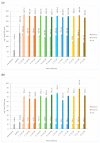Tuning the Bioactive Properties of Dunaliella salina Water Extracts by Ultrasound-Assisted Extraction
- PMID: 37755085
- PMCID: PMC10532918
- DOI: 10.3390/md21090472
Tuning the Bioactive Properties of Dunaliella salina Water Extracts by Ultrasound-Assisted Extraction
Abstract
(1) Background: Microalgae are promising feedstock for obtaining valuable bioactive compounds. To facilitate the release of these important biomolecules from microalgae, effective cell disruption is usually necessary, where the use of ultrasound has achieved considerable popularity as an alternative to conventional methods. (2) Methods: This paper aims to evaluate the use of ultrasound technology in water medium as a green technology to recover high added-value compounds from Dunaliella salina and improve its sensory profile towards a high level of incorporation into novel food products. (3) Results: Among the variables, the solid concentration and extraction time have the most significant impact on the process. For the extraction of protein, or fat, the most influential factor is the extraction time. Total polyphenols are only significantly affected by the extraction time. The antioxidant capacity is strongly affected by the solid to liquid ratio and, to a small extent, by the extraction time. Ultrasound-assisted extraction improves the overall odor/aroma of D. salina with good acceptability by the panelists. (4) Conclusions: The application of ultrasonic-assisted extraction demonstrates a positive overall effect on enhancing the sensory profile, particularly the odor of microalgal biomass, while the bioactive properties are preserved. Notably, the intense sea/fish odors are reduced, while earthy and citrus notes become more prominent, resulting in an improved overall sensory profile score. This is the first time, to our knowledge, that this innovative, green, and efficient technology has been used to upgrade the aroma profile of microalgae.
Keywords: Dunaliella salina; bioactivities; extraction; sensory analysis; ultrasound.
Conflict of interest statement
The authors declare no conflict of interest.
Figures








References
-
- Aschemann-Witzel J., Peschel A.O. Consumer perception of plant-based proteins: The value of source transparency for alternative protein ingredients. Food Hydrocoll. 2019;96:20–28. doi: 10.1016/j.foodhyd.2019.05.006. - DOI
-
- Ozcan Cetin E.H., Cetin M.S., Özbay M.B., Yaman N.M., Könte H.C., Ekizler F.A., Tak B.T., Kara M., Temizhan A., Özcan F., et al. The Other Side of the Medallion in Heart Failure: Reverse Metabolic Syndrome. Nutr. Metab. Cardiovasc. Dis. 2020;30:2041–2050. doi: 10.1016/j.numecd.2020.06.027. - DOI - PubMed
Grants and funding
LinkOut - more resources
Full Text Sources

